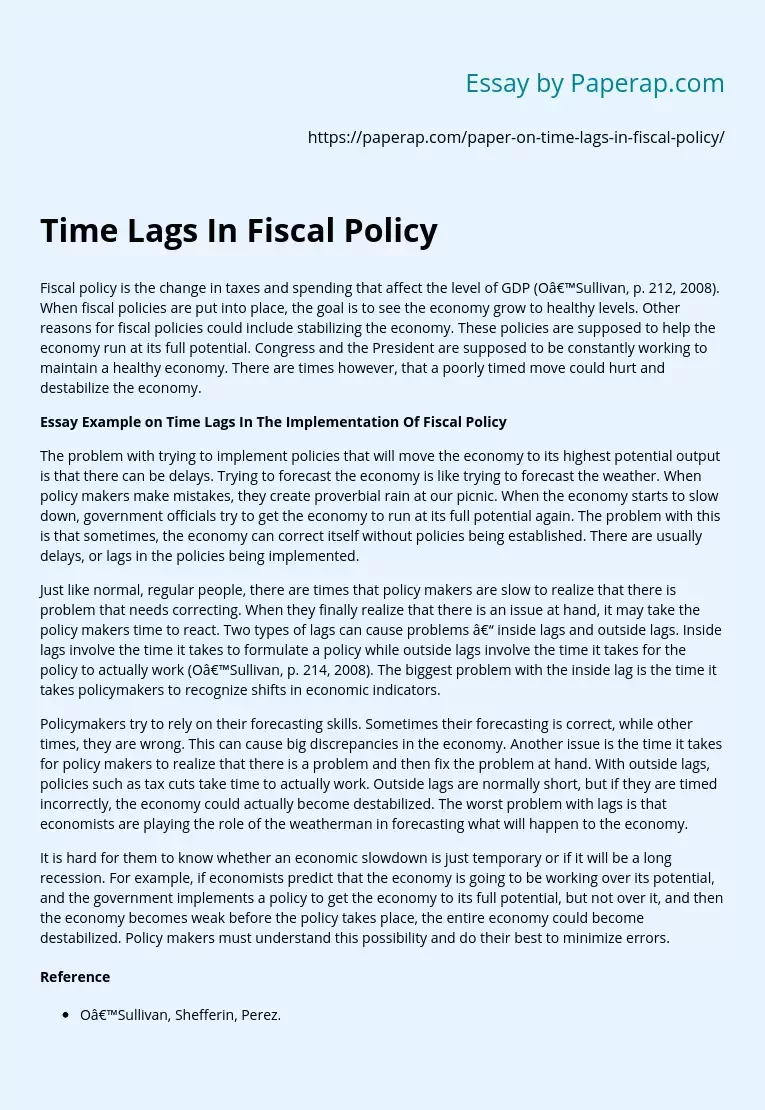Time Lags In Fiscal Policy
Fiscal policy is the change in taxes and spending that affect the level of GDP (O’Sullivan, p. 212, 2008). When fiscal policies are put into place, the goal is to see the economy grow to healthy levels. Other reasons for fiscal policies could include stabilizing the economy. These policies are supposed to help the economy run at its full potential. Congress and the President are supposed to be constantly working to maintain a healthy economy. There are times however, that a poorly timed move could hurt and destabilize the economy.
Essay Example on Time Lags In The Implementation Of Fiscal Policy
The problem with trying to implement policies that will move the economy to its highest potential output is that there can be delays. Trying to forecast the economy is like trying to forecast the weather. When policy makers make mistakes, they create proverbial rain at our picnic. When the economy starts to slow down, government officials try to get the economy to run at its full potential again.
The problem with this is that sometimes, the economy can correct itself without policies being established. There are usually delays, or lags in the policies being implemented.
Just like normal, regular people, there are times that policy makers are slow to realize that there is problem that needs correcting. When they finally realize that there is an issue at hand, it may take the policy makers time to react. Two types of lags can cause problems – inside lags and outside lags. Inside lags involve the time it takes to formulate a policy while outside lags involve the time it takes for the policy to actually work (O’Sullivan, p.
214, 2008). The biggest problem with the inside lag is the time it takes policymakers to recognize shifts in economic indicators.
Policymakers try to rely on their forecasting skills. Sometimes their forecasting is correct, while other times, they are wrong. This can cause big discrepancies in the economy. Another issue is the time it takes for policy makers to realize that there is a problem and then fix the problem at hand. With outside lags, policies such as tax cuts take time to actually work. Outside lags are normally short, but if they are timed incorrectly, the economy could actually become destabilized. The worst problem with lags is that economists are playing the role of the weatherman in forecasting what will happen to the economy.
It is hard for them to know whether an economic slowdown is just temporary or if it will be a long recession. For example, if economists predict that the economy is going to be working over its potential, and the government implements a policy to get the economy to its full potential, but not over it, and then the economy becomes weak before the policy takes place, the entire economy could become destabilized. Policy makers must understand this possibility and do their best to minimize errors.
Reference
- O’Sullivan, Shefferin, Perez. (2008). Economics: Principles, Applications, and Tools. Upper Saddle River, NJ: Pearson Education, Inc.
Time Lags In Fiscal Policy. (2019, Nov 27). Retrieved from https://paperap.com/paper-on-time-lags-in-fiscal-policy/

